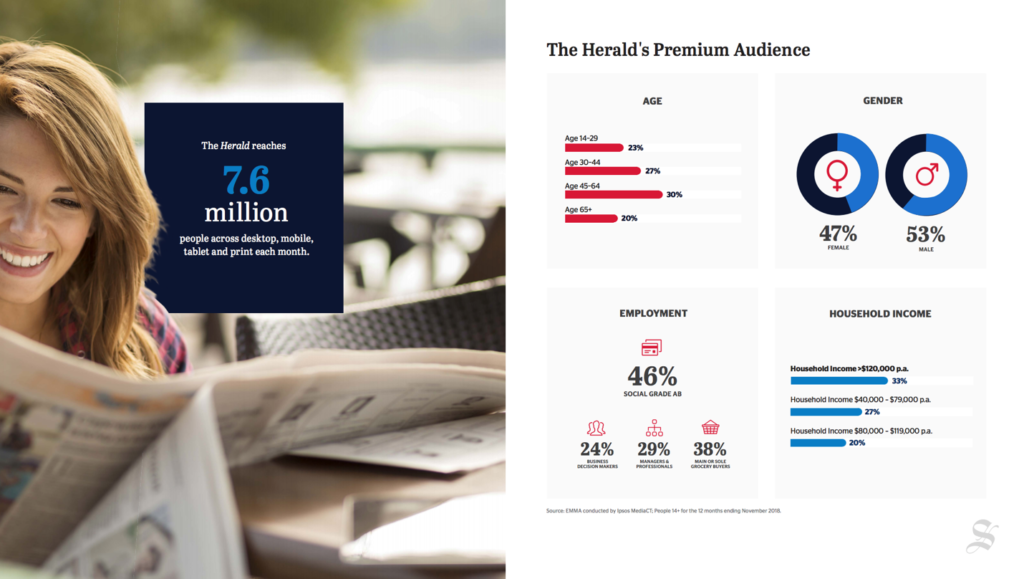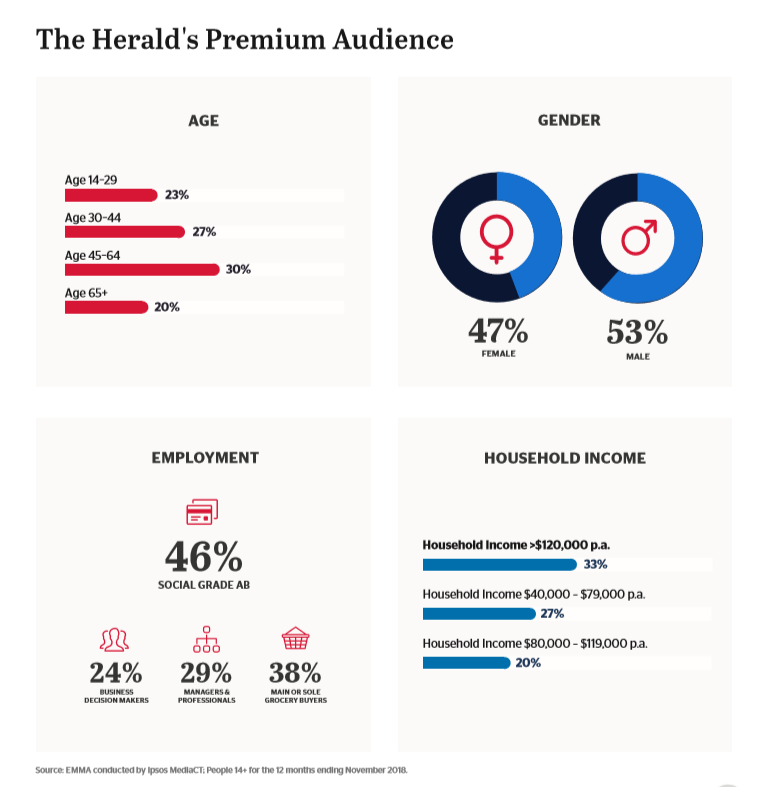
The news topic I choose is about the students march against climate change inaction. I would like to make a comparative analysis using this story from the two services:
The Sydney Morning Herald
‘Fantastic turnout’: School climate strike draws big crowd in Sydney
Crikey
Not kids anymore: climate students march with worldly passion
Biographical survey
- The Sydney Morning Herald
The Sydney Morning Herald (SMH), was founded in 1831 and launched the newspaper’s web edition in 1995, growing to include interactive and multimedia features beyond the content in the print edition. These years, it has become a leading Australian multi-platform media network, engaging audiences across news, business, lifestyle, food, parenting as well as travel.
The SMH has been producing for 187 years as the courageous, quality journalism deserved trust. According to the data of readership report for Australian newspapers from Roy Morgan Research (2017), the Sydney Morning Herald is the most widely read masthead with cross-platform readership of over 4.2 million each month.
As to the political viewpoint, The Sydney Morning Herald is centrist, guided by the editorial stance of “market libertarianism and social liberalism” (SMH, 2004).
- Crikey
Crikey was founded by activist shareholder Stephen Mayne, a journalist and former staffer of then Liberal Victorian premier Jeff Kennett, developing out of Mayne’s “jeffed.com” website. In 2005, it was announced that Crikey had been sold to Private Media Partners by Stephen Mayne.
Crikey has been Australia’s outstanding, independent digital news and commentary publication for the past 19 years, devoting itself to pushing the boundaries and digging deeper to find out the truth. It provides the readers the inside world related to politics, media, business, arts, sport and other aspects of public life in Australia. Mark Latham (2005), an Australian politician, described Crikey as the “most popular website in Parliament House”.
At Crikey, people can go anonymously or not with information they believe is in the public interest. The most important thing is that Crikey is independent and is not part of a media empire.
User analysis
- The Sydney Morning Herald

The Herald gets to understand its audiences through the aspects including age, gender, employment and household income. It is seen that the number of users at the age of 45 to 64 takes up the largest proportion, reaching 30% among all age levels. In addition, over half of the readers are male.
Nearly half of the audience are under the employment of Social Grade AB, who are informed, educated and looking to sources of news considered reliable and helpful to them. As illustrated, the percentage of audiences with household income more than $120k arrives at 33%. In this case, the channels of the Herald provide an ideal platform for brands seeking to connect with the country’s most affluent families and individuals.
- Crikey

Crikey looks insight into their users by data collecting of the traffic, income and education, age, location as well as gender. Generally, the unique audience members per month reaches to 400k and the average unique visitors is 13.5k per day. The average personal income of the audience is over $87k, while the average house hold income is more than $114k. It is shown that most of the Crikey’s users are well educated, with 42% have a postgraduate degree and 36% have a graduate degree. Additionally, many of the Crikey’s audience are Twitter followers and Facebook followers at the same time.
The majority of the users are males, among whom more than a half are over 56 years of old. A large proportion of the audience are located in busier area such as New South Wales and Victoria.
Journalism writing analysis
- The Sydney Morning Herald
The news story has a clear structure and relatively integrated content. It directly points out the event (school climate strike) and the purpose of the strike (to rally against climate change inaction) at the very beginning. In the following part, the statements from the speakers is quoted, refuting the rebukes from Prime Minister Scott Morrison and Premier Gladys Berejiklian. The quotations can make contribution to the enrichment of the content.
Furthermore, the specific data, including the number of participants and the countries concerned, could effectively enhance the reliability and accuracy of the news. Addressing Lord mayor Clover Moore’s encouragement and praise also leads to a persuasive effect.
There is a proper link to the Twitter page of Clover Moore, showing her post “A fantastic turnout at Sydney Square for today’s”, to verify the authenticity and supplement the details. Similarly, there are another four links in the news story in order to provide detailed explanation of certain news or policies. For instance, it is linked to a news story Teenage climate activist nominated for Nobel Peace Prize when mentioning the movement’s founder, 16-year-old Greta Thunberg.
As to the audiovisual enhancements to the story text, effective image and video clip are used to develop the text content. The image shows the scene of handreds of students gathering at Town Hall in Sydney to attend the climate strike, hand-hold “There is no planet B”, “one world one chance” placards. Also, the video clip presents the moving crowd of parading procession. It is clearly seen that there are truly a huge number of school students. However, it would be better if the speech could be linked in the form of video.
- Crikey
The news story on Crikey goes into the event and make great comments on the social phenomenon rather than merely state a fact. The introduction before main body draws readers’ attention and provoke thought at first glance, which says “The right continue to infantilise school students who have opinions” (Rundle, 2019).
In the first two paragraph, just similar as the SMH one, it describes a picture of the prominent students strike in Melbourne. The language is much more refined but powerful. The numbers of participating countries and the separate strikes is accurate, making the news in credibility. It also mentions the nonignorable 16-year-old young woman who parked the movement, and put a link to tell her story.
It is better considered as a news commentary than as a news story, for the reason that the highlight is the argumentation part with theories and practices. Step by step, it points out that teenagers need to break the rigidity of thinking and challenge the reality based on the protest against climate change inaction advocated by students.
There is only one relevant image through the whole text, probably due to the large amount of argument.
Online delivery analysis
- The Sydney Morning Herald
In this news story, the writer tends to use different approaches including hypertextual, interactive and multimedial technics to improve the reading experience. The hyperlinks are utilised at high frequency, regarded as the lifeblood of the web by Bradshaw (2018), making sense of its own and contributing to the text content as well. As Bradshaw notes, the further benefit of links refers to the effective accessibility and scannability. At the right side of the page, it provides links to news stories on this website with based on the same topic, which is convenient for users to build an integral understanding of certain issues.
For online journalism, interactivity plays a significantly important role, exactly as the position of sound to radio (Bradshaw, 2018). The SMH news story offers the readers high quality of interaction with not only the text content but also others users, where they are able to leave comments and have a discussion. It also allows users to share the news story to other platforms such as Facebook and Twitter. Besides, it gives users the chance to contact the authors by providing links to their e-mail address and Twitter account.
Additionally, visual technicians are effectively used in this storytelling. The image and video clip illustrate the spectacle of the throng of those striking students, which is quite hard to make subtle description with words. The reason is pointed out by Briggs (2016) that photograph is all about moment. Likewise, writers have long been told “to show, don not tell” (Briggs, 2016). Thus, multimedia used in the story is likely to replace complicated words, attract attention and enhance aesthetic effect.
- Crikey
Compared with the SMH one, this news similarly uses technics in relation to hyperlinks, interactivity as well as multimediality. The advantageous part is that it has the tag settings labelled as “climate change”, “students march”, etc. However, there is only one image and one link in it, providing basic visual support and certain background information. Many theories and arguments are quoted by the author without detailed explanations and context information. Therefore, maybe it is necessary to add some links to supplement and enrich the content.
Technical analysis
- The Sydney Morning Herald
The page is accessible and functional. All of the links works and the words are clear and easy to read with suitable line space. One thing is considerate that the words size can be adjusted as preferred. Nevertheless, the story text is sometimes separated by the web advertising, making the layout in disorder to some extent.
- Crikey
The page is functional with hyperlink, comment area and author contact information. The news story is arranged with short, proper paragraph, making it clear to read and understand. The whole page mainly uses three basic colours of black, white and red, completely meeting the aesthetic demand.
References
Briggs, M. (2016). Visual storytelling with photographs. In Journalism Next: a practical guide to digital reporting and publishing (3rd ed., pp. 153–184). CQ Press, SAGE.
ISBN: 978-1-4833-5685-3
Bradshaw, P. (2018). Writing for the Web. In The Online Journalism Handbook: Skills to survive and thrive in the digital age (pp. 72–98). Routledge.
Latham, M. (2005). The Latham Diaries. Melbourne Univ. Publishing.
Roy Morgan Research. (2017). Sydney Morning Herald is still Australia’s most widely read masthead and Australians continue to embrace the shift to digital news. Retrieved March 28, 2019 from http://www.roymorgan.com/findings/7306-roy-morgan-australian-newspaper-readership-june-2017-201708101543
The Sydney Morning Herald. (2004). It’s time for a vote of greater independence. Retrieved March 26, 2019 from https://www.smh.com.au/opinion/its-time-for-a-vote-of-greater-independence-20041008-gdjvnv.html





Be the first to comment